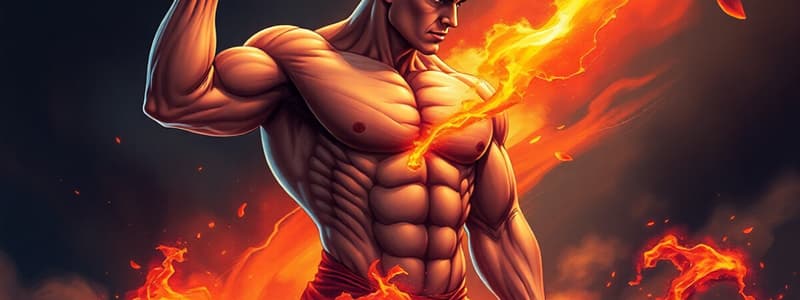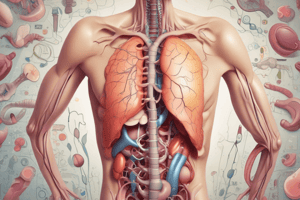Podcast
Questions and Answers
What was observed about muscle protein synthesis (MPS) in a 'basal' hormonal environment post-training?
What was observed about muscle protein synthesis (MPS) in a 'basal' hormonal environment post-training?
- MPS increased despite the absence of an anabolic hormonal environment (correct)
- MPS could only occur with weight training
- There was no increase in MPS
- MPS was dependent on high testosterone levels
Women cannot increase MPS without high post-exercise testosterone levels.
Women cannot increase MPS without high post-exercise testosterone levels.
False (B)
What factors are likely responsible for hypertrophy rather than the acute hormonal environment?
What factors are likely responsible for hypertrophy rather than the acute hormonal environment?
Intrinsic mechanisms of the muscle
The interference effect in concurrent training can limit adaptations of ___ and ___ training.
The interference effect in concurrent training can limit adaptations of ___ and ___ training.
Which of the following accurately describes strength training?
Which of the following accurately describes strength training?
Match the following training types with their characteristics:
Match the following training types with their characteristics:
A hormonal spike is significantly large compared to the normal diurnal variation.
A hormonal spike is significantly large compared to the normal diurnal variation.
What are the two categories of responders to hypertrophy training programs?
What are the two categories of responders to hypertrophy training programs?
What is the likely impact of endurance training on power?
What is the likely impact of endurance training on power?
Concurrent training cannot improve both strength and aerobic capacity.
Concurrent training cannot improve both strength and aerobic capacity.
What should be considered regarding the order of training sessions in a day?
What should be considered regarding the order of training sessions in a day?
Protein turnover includes both ________ and ________ states.
Protein turnover includes both ________ and ________ states.
Match the following concepts with their descriptions:
Match the following concepts with their descriptions:
What type of training may have less effect on strength?
What type of training may have less effect on strength?
Endurance training can lead to a significant increase in muscle protein synthesis for several hours.
Endurance training can lead to a significant increase in muscle protein synthesis for several hours.
Both concurrent groups showed a similar increase in ________.
Both concurrent groups showed a similar increase in ________.
Which hormone is NOT mentioned as influencing muscle hypertrophy?
Which hormone is NOT mentioned as influencing muscle hypertrophy?
Hypertrophy can only occur when there are acute hormonal responses post-exercise.
Hypertrophy can only occur when there are acute hormonal responses post-exercise.
What is the traditional view regarding hormones and muscle hypertrophy?
What is the traditional view regarding hormones and muscle hypertrophy?
Elevations in GH, T, and IGF-1 typically occur in training protocols with __________ volume.
Elevations in GH, T, and IGF-1 typically occur in training protocols with __________ volume.
Match the following factors with their impact on muscle hypertrophy:
Match the following factors with their impact on muscle hypertrophy:
According to contemporary thinking, what is the stance on hormonal influence in hypertrophy?
According to contemporary thinking, what is the stance on hormonal influence in hypertrophy?
The concurrent training effect refers to the competition between strength and endurance training for adaptations.
The concurrent training effect refers to the competition between strength and endurance training for adaptations.
What are two possible responder training effects in muscle growth?
What are two possible responder training effects in muscle growth?
Study Notes
Hormone Hypothesis
- Traditional view: Elevations in GH, T, and IGF-1 are key to muscle hypertrophy.
- Contemporary view: Muscle hypertrophy can occur without a major hormonal response.
Testing The Hormone Hypothesis
- Study used elbow flexors as the muscle group.
- Post-training conditions were either "basal" or "high" hormonal environment through lower body training.
- Increases in MPS in "basal" condition despite lack of anabolic hormones.
- Greater MPS was not seen in the "high" hormonal condition.
Arguments Against the Hormone Hypothesis
- Women can have substantial MPS without high post-exercise testosterone.
- Hypertrophy "responders" and "non-responders" are not explained by hormonal response.
- Post-exercise hormonal spike is small compared to natural daily fluctuation.
- Intrinsic muscle mechanisms likely drive hypertrophy, not acute hormonal environment.
Concurrent Training & Interference
- Most sports require a combination of strength and endurance.
- Training for both simultaneously may limit adaptation.
- Strength training is high intensity, short duration, and anaerobic.
- Endurance training is low force, medium to long duration, and various intensities.
Concurrent Training Concepts
- Muscle protein accretion is crucial for increasing muscle cross-sectional area.
- Endurance training can temporarily decrease muscle protein synthesis for several hours.
- Strength training during this period may negatively impact hypertrophy.
- The interference effect may impact strength and power.
Concurrent Training Mechanisms
- Endurance training mode is important, with power likely more negatively impacted.
- No decrements in aerobic performance.
- Running based concurrent training showed different outcomes than power-based activity.
Impact of Endurance Training on Strength, Hypertrophy, and Power
- Impact depends on the frequency and duration of endurance training.
Concurrent Training Outcomes
- No difference in 1RM leg press gains between separate and concurrent groups.
- Both concurrent training groups experienced similar increases in VO2 peak.
- CounterMovement Jump performance reduced when resistance training was performed before HIIT.
- Concurrent training can improve strength and aerobic capacity.
- Consider training order if the goal is to improve power.
Concurrent Training Recommendations
- Separate strength and endurance training on different days or with as much time between as possible.
- Consider nutritional support.
- HIIT may have less impact on strength.
- Consider training order within a day.
Studying That Suits You
Use AI to generate personalized quizzes and flashcards to suit your learning preferences.
Related Documents
Description
Explore the contrasting views on the hormone hypothesis regarding muscle hypertrophy. This quiz delves into the impact of growth hormone, testosterone, and their role in muscle growth. Examine contemporary findings surrounding hormonal responses and intrinsic muscle mechanisms.



